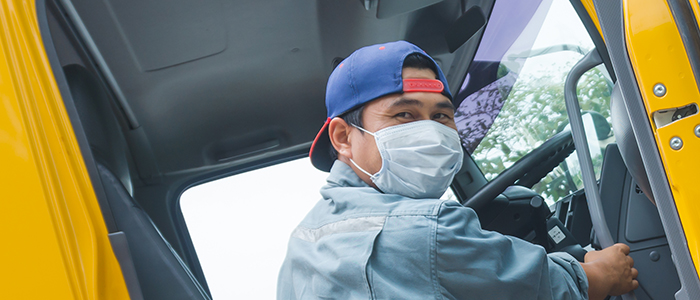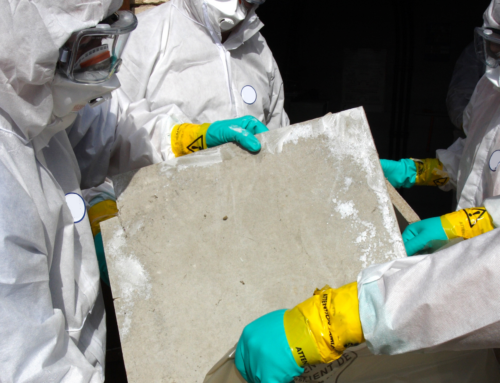Whether you’re a sole owner-operator or manage a large fleet of trucks, whether local-radius or long-haul, hauling goods means navigating risk both on and off the road. And with the COVID-19 virus still spreading, there are new risks related to the health and safety of employees.
Drivers are considered essential frontline workers, supporting the transportation of goods during a pandemic—including emergency relief, medical and sanitation supplies, as well as raw materials to manufacture personal protective equipment (PPE). But this also puts them at higher risk of coming into contact with COVID-19.
“Although COVID-19 has forced entire industries to rethink their operations and exposed some vulnerabilities, one thing remains absolutely certain: The Canadian supply chain’s ability to withstand these very trying and unpredictable times highly depends on the trucking industry and shippers and receivers working cohesively and sensibly together,” according to a statement by the Canadian Trucking Alliance (CTA).
By its very nature, the trucking industry involves multiple interactions between drivers and other individuals, such as shippers, receivers, maintenance providers, fuel station attendants, and border officials, as well as the general public at places like truck stops, restaurants, and hotels.
Since COVID-19 is still circulating, infection control is critically important—from the office to the road. While the situation is constantly evolving, there are steps that employers, fleet managers, and drivers can all take to minimize risk and stay safe.
Policies for infection control
It’s essential to have a plan—along with policies and procedures—to protect workers, particularly if they fall ill on the road. What happens if a driver develops symptoms of COVID-19 on a cross-border run into the United States? Employers should have a clear strategy on how to support drivers who must quarantine while on the road.
That includes instituting a company-wide policy that requires anyone with symptoms of COVID-19—such as sore throat, fever, sneezing, or coughing—to self-isolate at home for at least 10 days after the onset of symptoms. This policy should also outline physical distancing measures where employees must maintain a distance of at least two metres from other individuals or wear a non-medical face covering where physical distancing isn’t possible.
To encourage physical distancing, you may want to consider having some workers, such as dispatch and administration, continue working from home. You could also stagger start times for drivers to avoid overcrowding at terminal locations, as well as modify proof-of-delivery signature requirements, using digital tools where possible.
The First Ministers responsible for transportation and highway safety from all provinces and territories have collectively announced guiding principles for the use of masks, gloves, and other safety protocols for transportation employees. These are guidelines, not standards, but they’re meant to help mitigate the risk of transmission of COVID‐19.
Fleet management during COVID-19
Transport Canada in collaboration with the Public Health Agency of Canada (PHAC) recommend that fleet managers minimize the number of vehicles shared by employees to limit the spread of the virus between different users of the same vehicles. Review policies regarding slip-seating trucks and ensure drivers are assigned to the same equipment whenever possible.
Fleet managers should also ensure that drivers have access to appropriate disinfectants, hand sanitizer, disinfectant wipes, disposable gloves, and PPE such as masks, face shields, or respirators required to clean high-touch surfaces and to interact with the public where social distancing is not possible.
Dock workers and drivers will still need to be managed, even remotely. Communicate any policy changes—such as site access or required PPE—to all staff, drivers, and customers. If possible, share information on truck stops or rest stations with suitable personal hygiene facilities. And keep an up-to-date emergency contact list for all drivers in case they fall ill on the road.
Cleaning protocols on the road
Commercial vehicle drivers are responsible for cleaning and disinfecting their truck daily. That includes (but is not limited to) the following:
- Keys or FOBs
- Starter buttons
- Door handles
- Inside door grab handles
- Pads and armrests
- The steering wheel
- Shift lever and console
- Dashboard
- Power window and door lock switches
- Radio and climate control buttons
- Turn signal and wiper stalks
- Seat and seat adjuster
- Seat belt
- Touch screen
- Any other parts of the vehicle that may have been touched, such as the hood or cargo door handles
Use a hard-surface disinfectant authorized by Health Canada for use against COVID-19. Soiled cleaning cloths and gloves should be disposed of immediately in a waste disposal bag and hands should then be washed using proper hand-washing techniques (for a minimum of 20 seconds) as soon as possible.
If soap and water are not available, use an alcohol-based hand sanitizer as a temporary measure until you’re able to wash your hands. Look for sanitizer containing a 70 per cent (or more) alcohol concentration. Keep in mind, sanitizer may not be effective when organic material is on your hands; in this case, use wipes to remove the organic material, followed by sanitizer, and avoid touching your mouth, nose, and eyes.
When refuelling, consider wearing nitrile gloves before immediately disposing of them and washing your hands with soap and water. Also take precautions when touching service station door handles or handling automotive products required for vehicle maintenance, such as motor oil or windshield wiper fluid.
Staying safe on the road
If possible, drivers should remain in the cab during pickup and deliveries to limit exposure in shipping and receiving facilities. Avoid shaking hands and wave or nod in greeting instead. Send documents electronically if possible or make arrangements for you to sign on behalf of the shipper/receiver.
When outside the vehicle, do the following:
- Maintain a physical distance of at least two metres from others and wear a mask if social distancing isn’t possible.
- Consider wearing nitrile gloves instead of work gloves when loading and unloading, if it makes sense for the task at hand.
- Always wash your hands after each stop or delivery (or sanitize, if soap and water are not available).
Consider bringing your own food if it’s challenging to buy meals on the road due to restaurant closures, which could vary from region to region. Limit visits at truck stops, drivers’ lounges, repair shops, and other public gathering spots. In hotels and shower rooms, wipe down commonly touched surfaces such as doorknobs, chairs, and tables.
Some customers may have changed their site entry docking and delivery procedures during the pandemic. Call ahead to find out the site’s current requirements and send texts or call to alert the customer of your arrival.
Slip-seating trucks and team drivers: Drivers who work in a slip-seating operation or share a truck should increase their cleaning and disinfection protocols before and after each shift. For team drivers, ensure masks are worn if sitting within two metres of each other in the cab. Fleet managers should keep teams together; don’t swap out drivers if at all possible.
Cross-border commercial vehicle drivers: The PHAC requires all people, including commercial vehicle drivers, to wear a non-medical face covering upon entry to the country and while travelling to their destination in Canada. While commercial vehicle drivers are exempt from the 14-day quarantine requirements (which don’t apply to service workers for whom travel outside the country is deemed essential), they are required to self-monitor and abide by the recommendations of local and federal public health authorities.
What to do if you’re experiencing symptoms
Commercial vehicle drivers are advised to self-monitor their health prior to a trip. If experiencing symptoms, even a mild cough or low-grade fever (37.3°C or higher), you should stay home and advise your employer. If you start to experience symptoms after completing a trip, you should also stay home, self-isolate, and advise your employer so steps can be taken to protect your co-workers and other drivers using your truck.
If you’ve come into contact with anyone who has COVID-19 or related symptoms, you’re advised to self-declare to dispatch as well as your healthcare provider, and to self-isolate if instructed. Health Canada offers a self-assessment tool and the CTA has a website dedicated to posting updates related to COVID-19 for the trucking industry. Employers can also contact the PHAC directly at [email protected] for additional guidance.
Federated is here to help
During these unprecedented times, it’s important to stay up-to-date on the latest government requirements and recommendations, as well as any industry-specific guidance for your sector. Visit our COVID-19 resources page for resources and information on who to contact with any questions.






